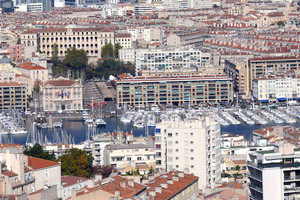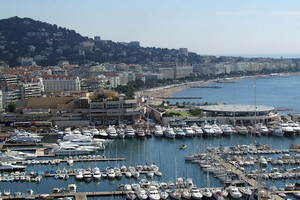
As the early morning sun rises above the Notre Dame de la Garde which towers over Marseilles, the quai de Belges is bathed in warm sunshine sparking the fishermen into action. They haul crates of seafood, caught overnight, from their boats moored nearby and set them out on tables as their female partners (literally the fishwives) call out to the shoppers who flock to the colourful market each morning. Within half an hour the quai is bathed in bright sunlight and packed with locals, and above the hubbub of the busy market, is a female voice with a beautiful rendition of Édith Piaf’s Non, je ne regrette rien (No Regrets). The music hangs perfectly over the setting with Marseille’s Vieux Port as a backdrop, and its source is an elderly crooner called Fanny who’s serenading passers-by with her Piaf covers. As buskers go, Fanny not only remains faithful to the original version, but she also knows how to work the crowd. She calls out the younger men in the crowd to join her “show” which pretty much consists of holding their hand and singing soulfully while looking deep into their eyes. Fanny clearly enjoys the embarrassment she causes her “victims”, and even the sleep-deprived fishermen are forced into a grin at least, and it’s a warm welcome to a port city with a bit of a reputation as being a rough-and-gruff type of place.
A Brief History Of Marseille
It used to be considered as a rough diamond of France, but Marseille has been polished into a piece that’s proving a real surprise for today's visitors. It's also a world away from the Provence as portrayed in travel shows, and absolutely nothing like the glitz and glamour of the Riviera, but instead it’s a working city with real people and a genuine charm which surprises many visitors. The film The French Connection in the 1970’s, which starred Gene Hackman, portrayed Marseille as a sleazy and dangerous gangster town, but these days the inner city suburbs and port area have been restored to provide a unique French experience. The city is France’s oldest, and was founded more than 2,000 years ago by the Greeks from the city of Phocea, and ever since it’s been a gateway for immigrants Italy, Greece, Turkey and North Africa. Today, it’s a dynamic multicultural city of just under one million people and the Vieux Port (or Old Port) is the heart and soul of Marseille, as it has been for centuries. It’s a well protected U-shaped bay with the old fortresses of St Jean and St Nicholas standing sentinel at its entrance which now welcomes mostly pleasure craft and smaller fishing boats. Trestle tables line the harbour front laden with an exotic mix of seafood and the nearby quays and arcades are lined with restaurants and cafés filled with locals who seem totally content to relax and watch the harbour life unfold in front of them.
Marseille Architecture
Despite its colourful history, Marseille has little Greek or Roman architecture still standing, but the more modern monuments capture the brashness of France’s second city. Towering above the city is the immense Notre Dame de la Garde - a Byzantine monument erected between 1853 and 1864 on the city’s highest hill. The domed Basilica can be seen from pretty much everywhere in Marseille and its bell tower is topped by a 10 metre tall gilded statue of the Virgin Mary on a 12 metre high pedestal - bullet holes mark the cathedral’s outer walls as evidence of the fierce fighting that took place during the city’s Battle of Liberation in 1944. Ornate architecture and fascinating history aside, this is a great place to gain an orientation of the sprawling city with its 360 degree views - with the Vieux Port below and the terracotta roofs which stretch into the distance. The Abbaye St-Victor is halfway up the same hill as the Notre Dame de la Garde and the 12th century Romanesque building houses the tombs of third and fourth century martyrs including those of St Cassien and St Victor himself, who apparently was ground to death between millstones by the Romans.
The Harbour, Le Panier
Back down at sea level and the Marseille Ferry Boat chugs back and forth across the Vieux Port - for a few coins you can cross from one side to the other and on the northern side the Hotel de Ville marks the hop-on-hop-off-point, which also leads to the city’s most fascinating suburb, Le Panier.The name literally translates as “the Breadbasket” and the area is a complex maze of unmapped streets set on a hill and walking Le Panier may leave you confused about which side of the Mediterranean you’re on. This is where many of the city’s immigrants congregated when they arrived from North Africa and even today market traders are more likely to call out in Arabic than in French. During WWII it was also a hideout for many Resistance fighters and Jewish people and although the German military razed the area many times, enough of it still remains to offer an authentic glimpse of Marseille’s oldest quarter. Like the rest of Marseille, Le Panier has no airs and graces and asks nothing of its visitors other than to give it a fair go, and if you dig deep enough you’ll find a slice of unique French culture with an eastern European and north African flavour.
- By:
- Ben Hall











